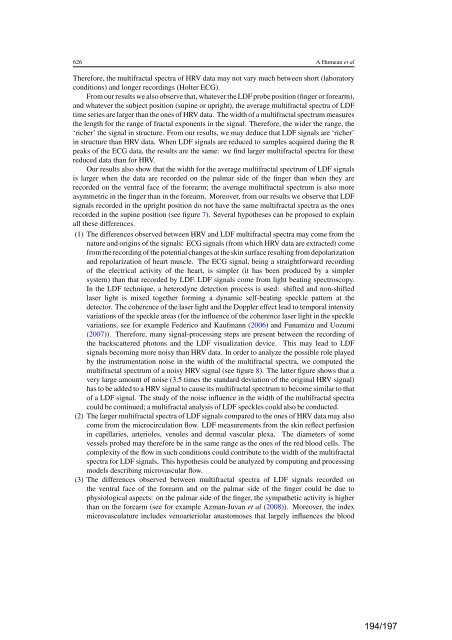a la physique de l'information - Lisa - Université d'Angers
a la physique de l'information - Lisa - Université d'Angers
a la physique de l'information - Lisa - Université d'Angers
You also want an ePaper? Increase the reach of your titles
YUMPU automatically turns print PDFs into web optimized ePapers that Google loves.
626 A Humeau et al<br />
Therefore, the multifractal spectra of HRV data may not vary much between short (<strong>la</strong>boratory<br />
conditions) and longer recordings (Holter ECG).<br />
From our results we also observe that, whatever the LDF probe position (finger or forearm),<br />
and whatever the subject position (supine or upright), the average multifractal spectra of LDF<br />
time series are <strong>la</strong>rger than the ones of HRV data. The width of a multifractal spectrum measures<br />
the length for the range of fractal exponents in the signal. Therefore, the wi<strong>de</strong>r the range, the<br />
‘richer’ the signal in structure. From our results, we may <strong>de</strong>duce that LDF signals are ‘richer’<br />
in structure than HRV data. When LDF signals are reduced to samples acquired during the R<br />
peaks of the ECG data, the results are the same: we find <strong>la</strong>rger multifractal spectra for these<br />
reduced data than for HRV.<br />
Our results also show that the width for the average multifractal spectrum of LDF signals<br />
is <strong>la</strong>rger when the data are recor<strong>de</strong>d on the palmar si<strong>de</strong> of the finger than when they are<br />
recor<strong>de</strong>d on the ventral face of the forearm; the average multifractal spectrum is also more<br />
asymmetric in the finger than in the forearm. Moreover, from our results we observe that LDF<br />
signals recor<strong>de</strong>d in the upright position do not have the same multifractal spectra as the ones<br />
recor<strong>de</strong>d in the supine position (see figure 7). Several hypotheses can be proposed to exp<strong>la</strong>in<br />
all these differences.<br />
(1) The differences observed between HRV and LDF multifractal spectra may come from the<br />
nature and origins of the signals: ECG signals (from which HRV data are extracted) come<br />
from the recording of the potential changes at the skin surface resulting from <strong>de</strong>po<strong>la</strong>rization<br />
and repo<strong>la</strong>rization of heart muscle. The ECG signal, being a straightforward recording<br />
of the electrical activity of the heart, is simpler (it has been produced by a simpler<br />
system) than that recor<strong>de</strong>d by LDF. LDF signals come from light beating spectroscopy.<br />
In the LDF technique, a heterodyne <strong>de</strong>tection process is used: shifted and non-shifted<br />
<strong>la</strong>ser light is mixed together forming a dynamic self-beating speckle pattern at the<br />
<strong>de</strong>tector. The coherence of the <strong>la</strong>ser light and the Doppler effect lead to temporal intensity<br />
variations of the speckle areas (for the influence of the coherence <strong>la</strong>ser light in the speckle<br />
variations, see for example Fe<strong>de</strong>rico and Kaufmann (2006) and Funamizu and Uozumi<br />
(2007)). Therefore, many signal-processing steps are present between the recording of<br />
the backscattered photons and the LDF visualization <strong>de</strong>vice. This may lead to LDF<br />
signals becoming more noisy than HRV data. In or<strong>de</strong>r to analyze the possible role p<strong>la</strong>yed<br />
by the instrumentation noise in the width of the multifractal spectra, we computed the<br />
multifractal spectrum of a noisy HRV signal (see figure 8). The <strong>la</strong>tter figure shows that a<br />
very <strong>la</strong>rge amount of noise (3.5 times the standard <strong>de</strong>viation of the original HRV signal)<br />
has to be ad<strong>de</strong>d to a HRV signal to cause its multifractal spectrum to become simi<strong>la</strong>r to that<br />
of a LDF signal. The study of the noise influence in the width of the multifractal spectra<br />
could be continued; a multifractal analysis of LDF speckles could also be conducted.<br />
(2) The <strong>la</strong>rger multifractal spectra of LDF signals compared to the ones of HRV data may also<br />
come from the microcircu<strong>la</strong>tion flow. LDF measurements from the skin reflect perfusion<br />
in capil<strong>la</strong>ries, arterioles, venules and <strong>de</strong>rmal vascu<strong>la</strong>r plexa. The diameters of some<br />
vessels probed may therefore be in the same range as the ones of the red blood cells. The<br />
complexity of the flow in such conditions could contribute to the width of the multifractal<br />
spectra for LDF signals. This hypothesis could be analyzed by computing and processing<br />
mo<strong>de</strong>ls <strong>de</strong>scribing microvascu<strong>la</strong>r flow.<br />
(3) The differences observed between multifractal spectra of LDF signals recor<strong>de</strong>d on<br />
the ventral face of the forearm and on the palmar si<strong>de</strong> of the finger could be due to<br />
physiological aspects: on the palmar si<strong>de</strong> of the finger, the sympathetic activity is higher<br />
than on the forearm (see for example Azman-Juvan et al (2008)). Moreover, the in<strong>de</strong>x<br />
microvascu<strong>la</strong>ture inclu<strong>de</strong>s venoarterio<strong>la</strong>r anastomoses that <strong>la</strong>rgely influences the blood<br />
194/197


